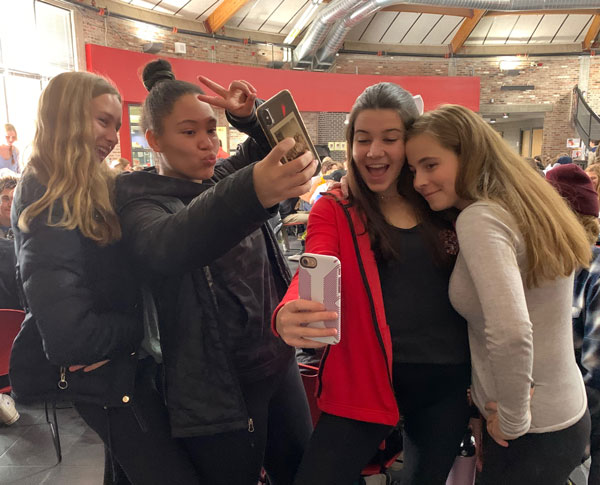The Language of Teenagers
Living with teenagers sometimes feels like my home has been invaded by foreigners who speak a different language. All day long, they take photos of themselves, making strange faces at their phones as they communicate with their friends through Snapchat.
To understand them, I’ve had to learn some of their bizarre vernacular. I hear words such as salty (angry), toxic (really, really bad), epic (really, really good), and butt-hurt (annoyed or offended). They use expressions like, “I could mess with that” when referring to something that piques their interest; or they might ask, “is he/she going to throw tonight?” which implies someone’s parents are out of town and they’re going to have a party; and when they want to leave, they will say, “wanna dip now?”
Occasionally, their slang words slip out of my mouth. The other day, I said the word lit to describe something I was excited about. Coming from a mother in her mid-forties, it sounded ridiculous. If I question them about a term I can’t decipher, a loud, squeaky, “WHAT?” will burst out of my mouth, making me cringe afterward because I sound exactly like my mother did when I was their age.
I recently watched a Saturday Night Live skit mocking Duolingo, the app where you can learn new languages. The parody version of the app taught adults how to speak to young children. Although it was funny, I thought it was a great idea. If there were a Duolingo that teaches parents how to talk to their teenage offspring—I’d be down for that (that’s teenage lingo for “I’d like that very much”). I could imagine myself practicing sentences every day like this: “Son, the paper you wrote the other day was sick,” or “OMG, I threw your dad some shade when he forgot to take out the trash.” TBH (to be honest), I sound stupid just writing these lines, and if I attempted to speak that way I’d get laughed at—with good reason.
What about teenage dating? That, too, has its own language, all of which takes place through Snapchat. Here’s one example of how a potential relationship might commence: A bunch of girls are hanging out, brainstorming who they should like next. Someone calls out a name, and when they’re all in agreement about that person, it’s time for the game to begin. If the boy and girl are not friends on Snapchat, she’ll reach out and make a request. If he accepts, then she’ll send the boy a picture of herself. If he snaps back with a photo, the initial dialogue is now open––but timing is an essential strategy and must be used with utmost precision. In other words, the girl will not snap back immediately after his response, otherwise she’ll appear too desperate. So she waits, anywhere from ten minutes to a few hours, before sending a return snap.
The snapping rally will continue until one of them adds words to the picture, i.e. “u gonna go to the football game?” If that happens, they move on to the next step, partaking in a limited conversation while still maintaining adequate time before responding. In some cases, to further the progression, a friend might have to reach out to the boy to clue him in that the girl likes him. The double snap, sending someone two snaps in a row before receiving a response, is a definite no-no, and could be a deal breaker. Leaving someone on read shows the sender that you opened the snap but haven’t responded. If this happens, the person left on read might suffer from a minor case of episodic psychosis. For example, the girl might begin to question if the boy likes her. She will wonder why he hasn’t responded or worry that she said something wrong. She’ll most likely FaceTime her friends to help analyze the situation, discussing it ad nauseam. If he finally responds to her snap, the game will resume. If he doesn’t, then it’s over, and she’ll have to move on from that boy. The third step is face-to-face contact. If the couple gets together in person and all goes well, then they we will be on their way to having an official relationship. Once that occurs, snapping will continue to be their primary source of communicating, diminishing the wait-time rules. As the relationship evolves, they’ll likely add FaceTime sessions to enhance their connection.
This dating methodology is a foreign concept to people my age and older. When we were teenagers, we often started relationships through the telephone, spending ample time getting to know someone by talking to them. Since we didn’t have cell phones, we had to wait until we were home to make a phone call. Spending time conversing with a potential partner allowed us to get to know them through the spoken word. To this day, I’m still a phone talker. When I want to catch up with someone with whom I haven’t heard from in a while, I want to hear their voice. I want to engage in a meaningful rapport. I’m not trying to make a case that my generation’s means of communication and dating rules are better; they’re just different. One day, in the distant future, when my children grow up and have their own families, like me, they will have to learn a new language to understand how their teenagers correspond with one another. Regardless of our ages, the most important lesson is to create human connections, and whether the getting-to-know-you period starts with photos, words, or voice is irrelevant––as long as the end goal is the same.


